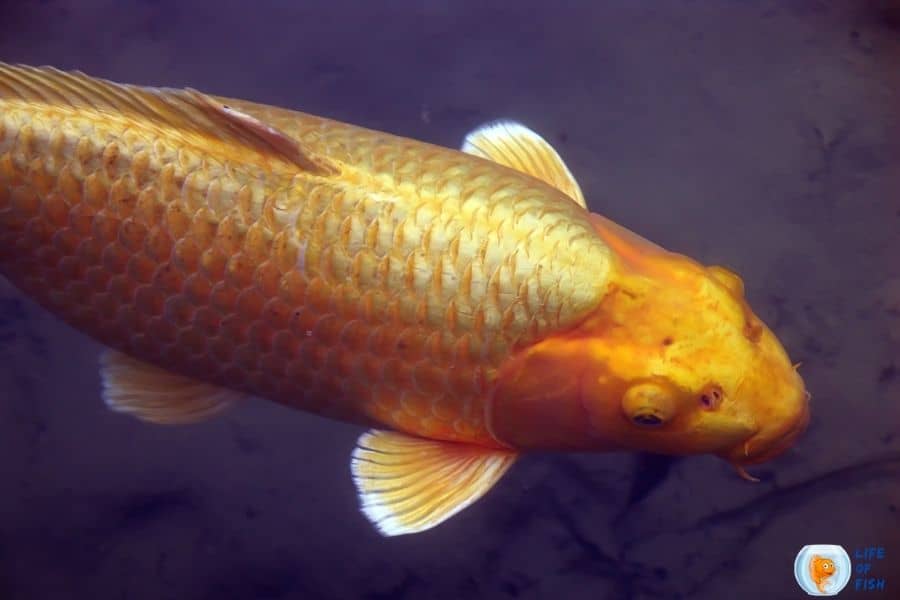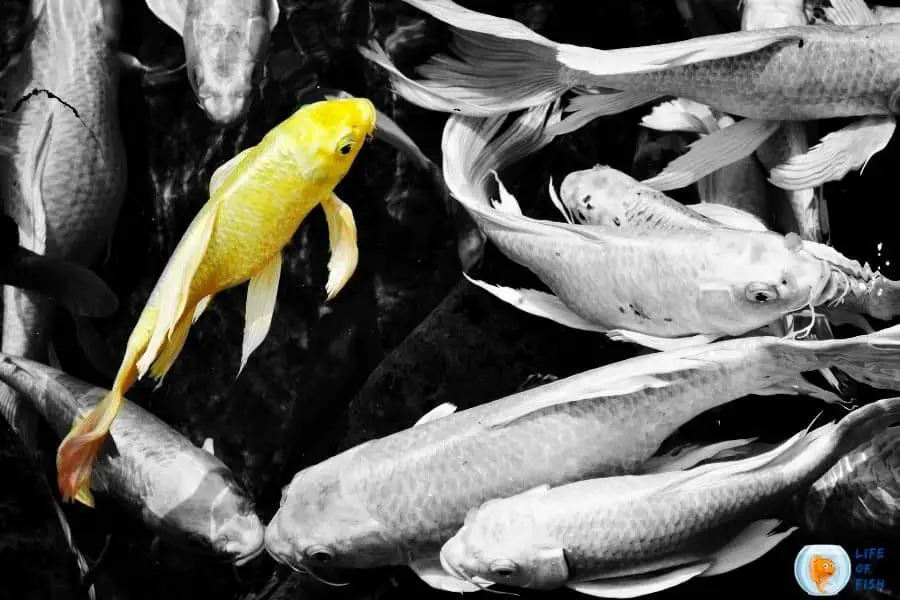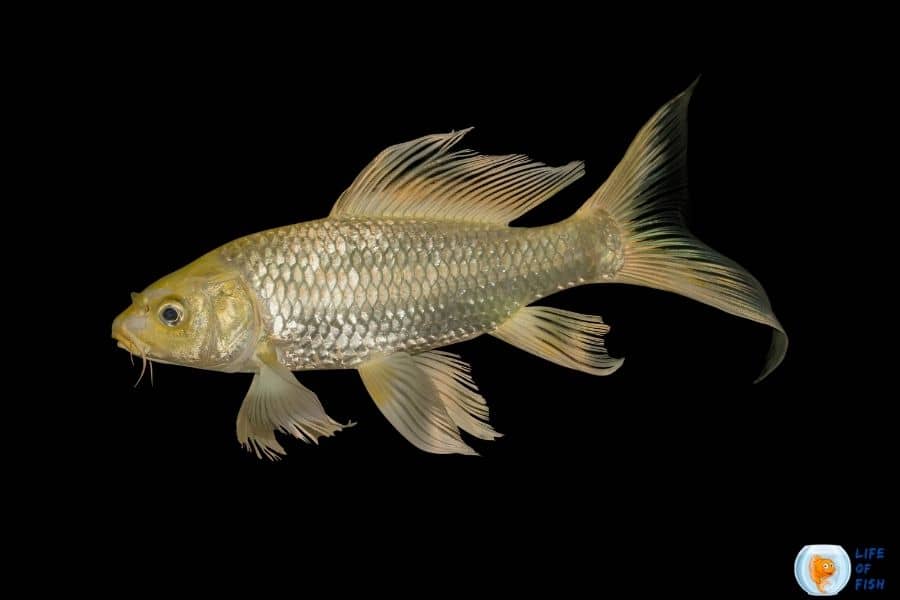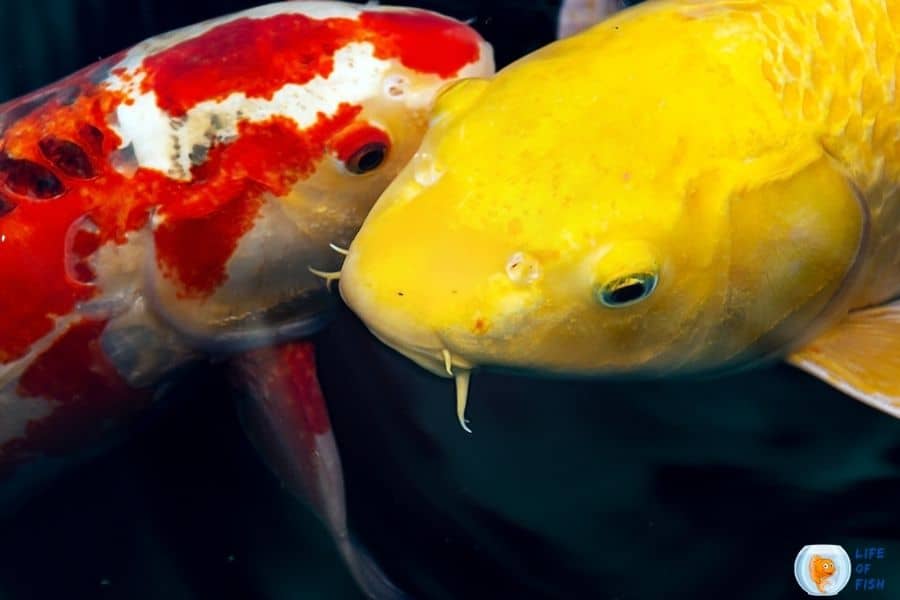Gold koi fish, also known as golden koi fish, are rare koi fish with a gold-colored body.
There is no doubt that koi are the most popular pond fish species globally. They are huge, attractive, and extremely easy to care for. Kois have different values depending on their body size and color morph.
They are not as common as other koi fish colors so they can be a bit more expensive. However, if you are fortunate enough to buy one, it is well worth the price!
This article is a care guide for keeping gold koi fish healthy and happy in your pond.

What is gold koi fish?
Jump To
- 1 What is gold koi fish?
- 2 How big do gold koi fish get?
- 3 Is gold koi fish a goldfish?
- 4 Is gold koi fish aggressive?
- 5 Gold koi fish behavior
- 6 How long do gold koi fish live?
- 7 One Look Care Guide
- 8 Gold koi fish care
- 9 Gold koi fish breeding
- 10 Special tips
- 11 How to feed gold koi fish?
- 12 What fish can live with gold koi fish?
- 13 How to tell if my gold koi fish is sick?
- 14 Related questions
- 15 Conclusion
As you may not know, there are more than 100 types of koi fish available in the aquarium trade.
Gold koi fish or golden koi fish are Ogon koi, precisely a Yamabuki koi type. They are classified as metallic koi because of their yellow-gold color.
This particular type of koi is not as common as other colors. So they can be a bit more expensive.
Gold koi fish are not only beautiful to look at, but they are also very hardy fish. They can survive in a wide range of temperatures, from about 50 degrees Fahrenheit to 86 degrees Fahrenheit.
Gold koi are also very adaptable to different water conditions and can live in both soft and hard water.
How big do gold koi fish get?
Gold koi fish can grow up to 24 inches in length, but the average size is about 12-16 inches. Their size may change according to the size of your pond.
Is gold koi fish a goldfish?
No. Gold koi fish is a type of koi, while goldfish are a type of carp.
Many people mistakenly call gold koi fish “goldfish,” as the name has “gold” and “fish” in it. But, it is important to understand that they are two different types of fish.
Is gold koi fish aggressive?
Gold koi fish are typically peaceful and easy-going fish, given that they are healthy and live in optimum water conditions.
Kois become aggressive when they don’t have adequate space, malnutrition, and illnesses, including stress and spawn. You can prevent these aggressions by providing a large enough pond and keeping pristine water conditions.
Gold koi fish behavior
Gold koi fish are very peaceful fish that swim around peacefully, not disturbing others.
They are usually the last fish to leave the pond in winter and the first to come back in the spring. They will eat all kinds of food but prefer live food.
Koi fish are known as jumpers. But they don’t jump often. If you see them jump a lot, it’s time to check water quality conditions.
Koi fish are not the usual hiders. If you observe your fish is hiding, that means something is wrong. Usually, koi fish hide:
- There is a predator
- They are sick or stressed
- Water quality is poor
- Introduced to a new tank.
If you observe this behavior, you will have to determine the underlying reason. Otherwise, these fish are calm and friendly.
What’s interesting about koi fish is that they can interact with humans. They can recognize their owner and come to the surface for food. You can even hand-feed them.

How long do gold koi fish live?
Gold koi fish can live more than 50 years when well cared for. But the average lifespan is 30 to 50 years. If living in poor water conditions, the lifespan will drastically reduce.
One Look Care Guide
| Scientific name | Cyprinus rubrofuscus |
| Common name | Gold koi fish Golden Koi fish Ogon koi Yamabuki ogon koi |
| Care level | Easy |
| Native to | Japan Selectively bred |
| Type | Freshwater fish |
| Color | Gold Metalic |
| Tank size | 250 gallons minimum |
| Preferred temperature | 68-75 degrees Fahrenheit |
| Other water parameters (ammonia, etc.) | pH level- 6-9 Hardness- 5-8dKH |
| Preferred salinity | No salinity |
| Size | 24 inches |
| Life Span | 30 to 50 years |
| Temperament | Peaceful |
| Recommended tank mates | Goldfish Minnows Killifish Catfish Perch Bass Sunfish Grass carp |
| Preferred food | Omnivorous, pellets, flakes, vegetables, and fruits |
| Feeding frequency | Two times per day |
| breeding | Easy, egg layers |
Gold koi fish care
Now that you know that koi fish require pristine water conditions to thrive let’s learn their exact needs and how to care for these fish.
Koi fish are easy-going fish that can tolerate extreme temperatures, but they require certain things to remain healthy.
Gold koi fish size
The average size of a gold koi fish is between 12-16 inches, but they can grow up to 24 inches in length. You must allow enough area in your pond for them to grow to their full size.
Gold koi fish tank size
Because of their potential adult size, each koi fish require at least 50 gallons of water to thrive.
So, if you keep a group of koi fish, you will have to provide a large pond of at least 3 feet deep and 250 gallons of water.
How many gold koi fish should be kept together?
While there is no maximum number of koi fish that can be kept together, it is recommended not to have more than ten koi in a pond as they will become aggressive towards each other.
If you have more than ten koi, make sure to provide them with enough space to swim and avoid overcrowding.
Pond setup
The pond setup for gold koi fish is pretty straightforward.
Koi fish require a heavily planted environment, so you would want to have a pond with plenty of plants and areas for them to hide. You should also provide a large boulder or similar structure for them to rest on.
The pond should be situated in an area that receives full sun and has access to a hose or spigot for easy water changes.
As for the substrate, you can use anything from rocks to gravel, but make sure to include a large area of pond liner to avoid any sharp objects that could injure the koi fish.
Water filtration is a must for koi fish, as they produce a lot of waste. You should use a good quality pond filter that can handle the load.
Water flow is not necessary for gold koi fish as these fish are used to living in slow-moving water. But, if you prefer, you can add a waterfall or fountain to your pond.
How to keep pond water clean for gold koi fish
The key to keeping your pond water clean and healthy for your gold koi fish is to perform regular water changes.
You should change 20-25% of the water every week, using a good quality pond water filter to remove debris and waste.
Water quality condition
Koi fish require a pH level of 6-9 and a water temperature of 68-75 degrees Fahrenheit. You can use a pond water test kit to check the pH and temperature of your water.
If the pH levels drop or elevate fast, you can use limestone to adjust them. If the water temperature drops, a pond heater can be used to bring it up. Kois can survive in ice-cold temperatures. But for the sake of their well-being, adding a heater is recommended.
The ideal water hardness of a koi pond is 5-8dKH. However, some hobbyists prefer to keep their koi in hardy water. If the koi are appropriately acclimated, they can actually live in hardy water.

Gold koi fish breeding
Although gold koi fish breeding is pretty straightforward, this requires a large separated tank or a pond, which is not easy for a typical hobbyist.
You can breed koi fish through natural spawning or by artificial insemination. In natural spawning, the male and female koi will spawn together, and the eggs will hatch within a few days.
In artificial insemination, the male and female koi are placed in a separate tank, and the koi are injected with hormones to induce spawning. The eggs are then collected and fertilized with sperm from another male koi.
The eggs are then incubated in a hatchery, and the newly hatched fry is transferred to a grow-out tank.
The fry will stay in the grow-out tank until they are large enough to be transferred to a pond.
Gold koi fish male or female identification
Identifying male and female gold koi is relatively straightforward.
The male specimen has a slender body while the female specimen is rounder. When it’s spawning season, the abdomen area of the female koi becomes more prominent and will be filled with eggs.
The male koi also has a more concave head, and the anal fin is larger and more pointed. The dorsal fin on the male koi is also taller and more pointed.
In addition, the male koi have a line in the underside from head to tail. The anal vent is pointed inward. It will release milt (sperm) when gently pressed.
Identify pregnant gold koi fish and gold koi fish pregnancy stages
Technically, koi do not get pregnant as they do not give birth to fish babies. Kois are egg layers, and the eggs are fertilized outside the female’s body.
However, you can identify a pregnant koi by her rounded abdomen. The eggs will be visible through her scales and will be a creamy or amber color.
Gold koi fish natural breeding
When you plan to breed koi naturally, you will have to wait for their spawning season. Kois usually spawn during May and June when the water temperature is 64-72 degrees Fahrenheit.
The male and female koi will be placed together in a tank or pond, and they will spawn within minutes.
You should put 2 to 3 male specimens for every female specimen in the breeding tank. The koi eggs will hatch within 3 to 4 days, and the fry will be transferred to a grow-out tank.
But, before spawning, you will have to condition them by feeding a diet high in proteins. Larger, older females are considered more fertile.
How many babies do gold koi fish have?
The amount of koi eggs depends on the size of the female fish.
A 2 pound female lays approximately 100000 eggs, whereas a 1 pound female lays about 50000 eggs.
Although koi fish lay many eggs at a time, only about half of the eggs survive and hatch. Even after hatching, almost half of the fries do not survive.
So, in one breeding session, you can expect from 12000 to 25000 surviving babies.
Gold koi fish fry care
The eggs will start to hatch within 72 hours after being fertilized, and the newly hatched fry will be a dark black color.
The fry will grow to adult size in about two years and reach sexual maturity at three years old.
The fry will require a lot of food and should be fed a diet of high-quality, live foods. You can provide the fries with commercial fish food, but you should also supplement their diet with brine shrimp, bloodworms, and tubifex.
The fries should be in a grow-out tank until they are about 1-1/2 inches long. You can then transfer them to a pond.
The fries are susceptible to many diseases and should be monitored closely for signs of illness.

Special tips
Koi are very friendly with humans and love to be petted and handled.
Be sure to keep them in a large enough tank or pond for breeding koi, as they will need more space to swim.
How to feed gold koi fish?
Koi fish are omnivorous and eat various foods, including commercial fish food, live food, and vegetables. They have a voracious appetite, so they will accept any food you offer them.
You should feed koi a high-quality diet, consisting of both live and processed foods. The diet should be well-balanced and include a wide range of foods, including:
- Commercial fish food pellets
- Brine shrimp
- Bloodworms
- Tubifex Worms
- Earthworms
- Cucumbers
- Zucchini
- Lettuce
- Pumpkin
- Squash
- Green beans
- Peas
- Carrots
- Pear
- Banana
- Strawberries
- Blueberries
You can feed larger koi a diet of about 1-1/2 to 2 pounds of food per week. You can feed smaller koi a diet of about 1/2 to 1 pound of food per week.
As koi tend to eat and uproot aquatic plants, providing plenty of algae and floating weeds is essential to avoid over-grazing.
Be sure to clean the tank or pond regularly to avoid excess waste build-up.
What fish can live with gold koi fish?
As koi fish are pond fish, you will have to find fish that can survive in a pond setting.
Fortunately, it’s not difficult to find suitable tank mates for koi. Although koi are powerful fish, they will not harass other fish as long as they get enough space to explore.
However, smaller fish would not be a good choice as they can become prey to gold koi. The most popular tank mate of koi is goldfish.
They have quite similar requirements as well as appearance. Bothe fish species come in various colors, including white, black, red, orange, and yellow.
Other fish that can live with koi include:
- Minnows
- Killifish
- Catfish
- Perch
- Bass
- Sunfish
- Grass carp
Do not house these fish with bluegills or Cyprinids, as they will bully and harass them.
How to tell if my gold koi fish is sick?
Koi are susceptible to a variety of diseases and can become sick often. It is essential to recognize symptoms of illness to provide treatment.
The most common diseases that koi are susceptible to include:
- Columnaris
- Fin rot
- Ichthyophonus
- Saprolegnia
- Koi herpes virus
Many other diseases can affect koi, so it is important to be familiar with the symptoms.
Some common signs of illness include:
- Loss of appetite
- Inactivity
- Scales standing out from the body
- Redness or inflammation around the fins
- White spots on the body or fins
- Unusual swimming behavior
- Labored breathing
- Discoloration
- Ulcers or sores on the body
If you notice any of these visible symptoms, you must isolate the fish and treat it with medication.

Related questions
Are gold koi fish rare?
Gold koi fish are not the rarest koi species, but they are rare, making them more expensive than other koi colors.
How much is a golden koi fish?
A 6-inch high-quality golden koi fish will cost you up to $100, while a fully grown golden koi fish may worth up to $21000.
Where can I buy a golden koi fish?
You can purchase a golden koi fish from most pet stores that carry fish. They are also available from a variety of online retailers.
Can I keep a golden koi fish in a tank?
Yes, you can keep a golden koi fish in a tank, but you will need a massive tank as they can grow up to 24 inches long. Be sure to provide plenty of space for them to swim.
Conclusion
Gold koi fish care is not difficult but does require some attention. We recommend more common koi breeds like the Nishikigoi if you are a beginner fish keeper.
Gold koi are beautiful fish and make a great addition to any pond or aquarium, but they come with a higher price tag. You can help maintain your gold koi fish healthy and happy by implementing the advice and guidelines in this article.
Read Next : Koi Guppy (Poecilia Reticulata) Care |Complete and Easy Guide| What Is a Koi Betta Fish? | Koi Bettas Care Tips You Must Know
